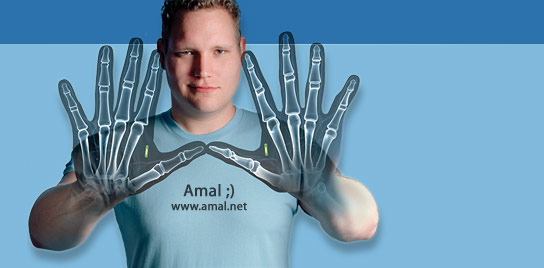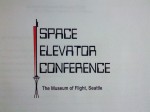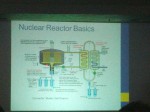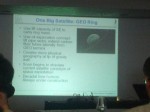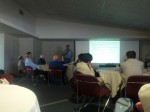When I saw the Space Elevator Conference was in Seattle, I asked GeekWire to get me in under the guise of being a pesky reporter. Press pass in hand, I entered the rough and tumble world of Space Elevator enthusiasts where just about anything goes. Here’s the write-up I did for GeekWire: http://www.geekwire.com/2012/wild-west-imagining-future-space-elevators (pdf)
When I walked into the small conference room on the second floor of the Museum of Flight this weekend, I wasn’t sure I was in the right place. A handful of tables, each surrounded by only a smattering of chairs, was all that the 10th annual Space Elevator Conference appeared to consist of. I was genuinely worried that the talks would be chock full of long, drawn out, boring filler.
Fortunately, I was wrong. I quickly went from being worried to feeling disappointed that I was only able to spend half a day with this room full of geeky, educated, PhD/engineering types who all dream big impossible dreams and have nothing but smiles on their faces as they debate and banter ideas around. The talks I heard ranged from potential international legal issues surrounding the placement of a space elevator ground station, to the economics of space elevators that would allow us to mine the Moon for Helium-3 to power fusion reactors on Earth.
There were several great talks, but the one that caused a sense of wonder and excitement to well up inside me was presented by space transportation consultant Hugh Cook. When I say these guys dream big, I’m not just talking about the seemingly impossible task of building a functional space elevator. Hugh really did try to do the impossible: predict what would happen once the potential of space elevators is fully realized. Shattering any paradigm always brings with it a chaos of human imagination and ingenuity springing forth in totally unpredictable ways.
Right now, space is not a destination. It’s not a “there” that any of us can get to, unless you are independently wealthy. Space elevators would change that, making outer space easily reachable for the common man. Just as the discovery of the New World created a destination for adventurous settlers and rugged cowboys alike, space as a destination will create a new ideal for spacefaring settlers and meteor wranglers to strike out on their own and make their marks.
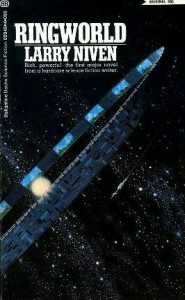 Cook described a world in which a Niven-esque ring was constructed around the planet. Initially built by robots, humans would soon inhabit the ring. Satellites could become unnecessary, as just about any communications or observational equipment could easily be bolted on to the ring. Asteroids coming in from the Kuiper belt could be refined in orbit and space-mined resources could be sent down on elevators or off to colonies on the Moon and Mars. Mom-and-Pop space junk janitorial services could spring up, taking on the task of removing debris from heavily polluted orbital planes.
Cook described a world in which a Niven-esque ring was constructed around the planet. Initially built by robots, humans would soon inhabit the ring. Satellites could become unnecessary, as just about any communications or observational equipment could easily be bolted on to the ring. Asteroids coming in from the Kuiper belt could be refined in orbit and space-mined resources could be sent down on elevators or off to colonies on the Moon and Mars. Mom-and-Pop space junk janitorial services could spring up, taking on the task of removing debris from heavily polluted orbital planes.
Just as terrestrial seafaring gave rise to port cities becoming rich and powerful city-states, ring denizens would likely recognize the power of their own economy and possibly declare their own sovereignty. With space elevators, humanity would have an economically viable gateway to the stars, and the unstoppable tide of human expansion into the solar system would most certainly follow.
Overall, the sense I got from these guys is that both the technology and the possibilities that space elevators evoke, truly represent the new Wild West. Almost no idea is off the table, and a feeling that anything is possible permeates the entire subject… and they were all too happy to answer my insultingly ignorant questions.
Q: So how “high” does the space elevator counterweight need to be?
A: It depends (doesn’t it always). For an Earth based tether, the generally accepted altitude is 100,000km based on work done by Bradley C. Edwards. For a lunar based tether, the counterweight needs to extend beyond the point of no return between the Earth and the Moon. This is because the moon’s rotation is too slow to provide enough centripetal force to create the necessary tension.
Q: So why is the thin ribbon shape for the tether the most popular option?
A: There isn’t much the SE community tend to agree on, but tether shape happens to be one of them. A great property of a ribbon shaped tether is that it can withstand damage sustained from meteoroid impacts. The small hole created by the impact of a small meteoroid in a single-strand rope-like tether could completely sever the tether, while that same small hole in a ribbon would constitute only minor damage. The other primary benefit to a wide thin ribbon is the amount of available surface area for simple friction based rollers to go up and down on.
Q: So the basic concept is, you have a climber that goes up, delivers payload, and comes down? How long does a round-trip take to complete and how much “stuff” can you take up in one trip?
A: Here is a commonly used example; Suppose your tether can withstand 20 metric tonnes of tension, and your vehicle weighs 6 metric tonnes. That means your cargo can weigh about 14 metric tonnes. If you only have one tether, you could deliver 14 metric tonnes of cargo to geosynchronous orbit (35,786km) at an average speed of 200km per hour. At that speed, it would take a little over 7 days to reach geosynchronous orbit. If you had two or more tethers, you could send up several vehicles at a time on a single tether and bring them down on another. The reason you can do this due to the Inverse Square law, which details exactly how much Earth’s gravity loses strength the further away you get.
I ended my time with these dreamers enjoying post-conference Thai food, talking about lasers, ribbon vibration mitigation techniques, ion drives, pulsed power supply options, space based solar power, and a highly speculative approach to space-based computational arrays and mesh communications based on thousands of orbiting 18 centimeter thinsats all working together in a mega-cluster. What an amazing day!
Tags: math, space, technology



